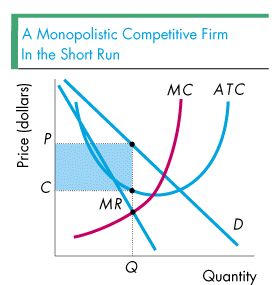Chapter 13
Monopolistic competition is an industry that many students and observers find realistic. Monopolistic competition is characterized by
- A large number of firms
- Freedom to enter or exit the industry
- Each firm produces a product slightly different from that of its competitors.
The restaurant industry is an example of a
monopolistically competitive industry. Restaurants easily fit
the three characteristics listed above: Any town of more than
reasonable size possesses a great many restaurants; it is
easily to start up - or stop - a restaurant; and, each
restaurant's food is different from the other restaurants in
town. Thus the restaurant industry is monopolistically
competitive.
A monopolistic competitive industry is a cross between a
perfectly competitive industry and a monopoly. In particular,
the first two characteristics on the list are similar to
those in a perfectly competitive industry and, for this
reason, account for the "competition" part of the
name. The last characteristic means that each firm holds a
(slight) monopoly over its particular variation of the
product and so it accounts for the "monopolistic"
portion of the name.
In the short run, the "monopoly" characteristic
of the industry is dominant. This fact means that the diagram
we use to understand a monopolistically competitive firm's
pricing and output decisions in the short run is the same
figure that we use to study a monopoly's pricing and output
decisions. For a concrete example, suppose that there are no
restaurants within 25 miles of the campus. Now, suppose that
one restaurant opens up next to campus. This restaurant has a
virtual monopoly. It's not a real monopoly because you can
bring food to campus, go home to eat, dine on candy from
machines, and in other ways avoid going to the restaurant.
But, at least immediately, it has close to a monopoly on
dining out off campus. And, with this
"close-to-a-monopoly" status, we can use the same
method of analyzing its short-run behavior as we did with a
monopoly.
So, how do we analyze a monopolistically competitive firm?

The figure shows the monopolistically competitive restaurant in the short run. The demand for the firm's meals is D with the associated marginal revenue curve MR. The restaurant's marginal cost curve is MC and its average total cost curve is ATC. The restaurant produces Q meals, determined by where the marginal revenue and marginal cost curves intersect. Then, the restaurant charges P for its meals, the highest price it can set and still sell all that the meals it produces. Now, it is important to note that this figure is exactly the same as what we used for a monopoly firm.
The restaurant in the figure is able to earn an economic
profit. The economic profit is equal to the area of the blue
rectangle. The fact that the restaurant can earn an economic
profit makes sense: It's the only restaurant in the area and
so its profit should be high. If the restaurant were a true
monopoly, high barriers to entry would protect the economic
profit and the profit could persist indefinitely. But it's
not a monopoly; it's a monopolistically competitive company.
And, in a monopolistic competition, other firms are free to
enter the market. In other words, other restaurants are free
to open up close to campus. And, when they see the profit
that the first restaurant is earning, you can bet your last
dollar that they will do so!
Thus the diagram shows only the short run equilibrium for
this firm. As time passes and we move to the long run, new
restaurants will open. What happens when new restaurants open
up? Click on the figure below to find out.